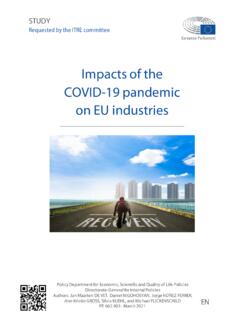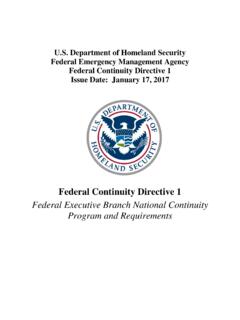Transcription of and Resilience Facility Regulation - European Commission
1 EN EN European Commission Brussels, C(2021) 1054 final Commission Notice Technical guidance on the application of do no significant harm under the recovery and Resilience Facility Regulation 1 Commission Notice Technical guidance on the application of do no significant harm under the recovery and Resilience Facility Regulation This document is based on the text of the Regulation on the recovery and Resilience Facility as politically agreed between the European Parliament and the Council in December 2020 (2020/0104 (COD))1. This technical guidance is intended to assist national authorities in the preparation of the recovery and Resilience Plans under the recovery and Resilience Facility Regulation .
2 Only the Court of Justice of the European Union is competent to authoritatively interpret Union law. The Regulation establishing the recovery and Resilience Facility (RRF) provides that no measure included in a recovery and Resilience plan (RRP) should lead to significant harm to environmental objectives within the meaning of Article 17 of the Taxonomy Regulation2, 3. According to the RRF Regulation , the assessment of the RRPs should ensure that each and every measure ( each reform and each investment) within the plan complies with the do no significant harm principle (DNSH)4. The RRF Regulation also states that the Commission should provide technical guidance on how DNSH should apply in the context of the RRF5.
3 The present document provides this technical guidance. This guidance is limited to setting out the modalities of the DNSH application in the context of the RRF only, taking into consideration its specific characteristics, and is without prejudice to the application and implementation of the Taxonomy Regulation and other legislative acts adopted in relation to other EU funds. This guidance aims to clarify the meaning of DNSH and how it should be applied in the context of the RRF, and how the Member States can demonstrate that their proposed measures in the RRP comply with DNSH. Concrete worked out examples on how DNSH should be demonstrated in the plans are provided in Annex IV to this guidance.
4 1 The numbering and the wording of the enacting provisions are subject to modifications during the ongoing legal revision. 2 See Article 4a ( Horizontal principles ) of the RRF Regulation (which states that the RFF can only support measures that respect DNSH) and Articles 15 and 16 ( recovery and Resilience plan and Commission assessment ) (which further set out that the RRPs should explain and be assessed in light of how the plan ensures that no measure for the implementation of reforms and investments included in the plan makes a significant harm to environmental objectives within the meaning of Article 17 of Regulation (EU) No 2020/852 ( do no significant harm ) ).
5 3 The Taxonomy Regulation refers to Regulation (EU) No 2020/852 on the establishment of a framework to facilitate sustainable investment, by setting out a classification system (or taxonomy ) for environmentally sustainable economic activities. 4 The Assessment guidelines for the Facility annexed to the RRF Regulation set out a number of assessment guidelines as a basis for the Commission to assess the proposals for RRPs as submitted by the Member States. The Commission is therein requested to use a rating system, ranging from A to C, for all the Commission assessment criteria listed in Article 16(3) of the Regulation . Assessment criterion (d) clarifies that for the assessment of DNSH, the Commission has only two rating options, A or C.
6 A if no measure within a RRP leads to significant harm to environmental objectives and C if one or more measures lead to significant harm to environmental objectives (within the meaning of Article 17 ( Significant harm to environmental objectives ) of the Taxonomy Regulation ). That Annex stipulates that a RRP does not comply satisfactorily with the assessment criteria as from the occurrence of a single C . In such a case, the plan could not be endorsed by the Commission . 5 This technical guidance document supplements the initial guidance already provided by the Commission in the Annual Sustainable Growth Strategy 2021, and the accompanying staff working document and updates thereof. 2 1. WHAT IS DO NO SIGNIFICANT HARM ?
7 For the purposes of the RRF Regulation , DNSH is to be interpreted within the meaning of Article 17 of the Taxonomy Regulation . This article defines what constitutes significant harm for the six environmental objectives covered by the Taxonomy Regulation : 1. An activity is considered to do significant harm to climate change mitigation if it leads to significant greenhouse gas (GHG) emissions; 2. An activity is considered to do significant harm to climate change adaptation if it leads to an increased adverse impact of the current climate and the expected future climate, on the activity itself or on people, nature or assets6; 3. An activity is considered to do significant harm to the sustainable use and protection of water and marine resources if it is detrimental to the good status or the good ecological potential of bodies of water, including surface water and groundwater, or to the good environmental status of marine waters; 4.
8 An activity is considered to do significant harm to the circular economy, including waste prevention and recycling, if it leads to significant inefficiencies in the use of materials or in the direct or indirect use of natural resources, or if it significantly increases the generation, incineration or disposal of waste, or if the long-term disposal of waste may cause significant and long-term environmental harm; 5. An activity is considered to do significant harm to pollution prevention and control if it leads to a significant increase in emissions of pollutants into air, water or land; 6. An activity is considered to do significant harm to the protection and restoration of biodiversity and ecosystems if it is significantly detrimental to the good condition and Resilience of ecosystems, or detrimental to the conservation status of habitats and species, including those of Union interest.
9 2. HOW SHOULD DNSH BE APPLIED IN THE CONTEXT OF THE RRF? This section provides guidance on key issues underlying the DNSH assessment: the fact that all measures need to be addressed as part of the DNSH assessment (Section ), although for certain measures the DNSH assessment can take a simplified form (Section ); the relevance of EU environmental legislation and impact assessments (Section ); the core guiding principles of the assessment (Section ); and the applicability of the technical screening criteria of the Taxonomy Regulation (Section ). All measures need to be addressed as part of the DNSH assessment Member States need to provide a DNSH assessment for each and every measure7 of their RRP.
10 According to the RRF Regulation , no measure included in a RRP should entail significant harm to environmental objectives, and the Commission cannot assess positively the RRP if one or more measures do not comply with DNSH. As a consequence, Member States need to provide an individual DNSH assessment for each 6 This means specifically that significant harm to the objective of climate change adaptation can be done by either (i) not adapting an activity to the adverse impacts of climate change when that activity is at risk of such impacts (such as a building in a flood-prone area), or (ii) by maladaptation, when putting in place an adaptation solution that protects one area ( people, nature or assets )















